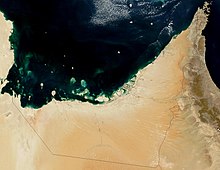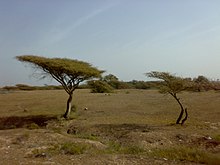Geography of the United Arab Emirates
The geography of the United Arab Emirates is the description of the physical condition of the national territory of the United Arab Emirates (UAE) as well as the resulting interactions between this habitat and its inhabitants.
physical geography
topography
The UAE is almost completely covered by dry sand desert ; Over two thirds of the country is occupied by the northern foothills of the Great Arabian Desert ( Rub al-Chali ). Their sand dunes can often migrate hundreds of kilometers and threaten oases and cities. Large-scale plantings could only partially stop the advance of the desert. The most important desert oases are Al-Ain / Buraimi in the border area with Oman and the Liwa oasis in the south. Between the sandy desert and the north coast there is a 15 km wide salt marsh plain with salt pans and brackish groundwater. There are many islands off the north coast; 100 km from the coast the sea is only 25 m deep. The islands, sandbanks , shoals and coral reefs still hinder shipping today. In the north-east, on the headland between the Persian Gulf and the Gulf of Oman , the northern section of the Hajar Mountains rises steeply : rising steeply out of the desert, it reaches two of its highest peaks in the UAE in the Jabal Adhan (1127 m) and in the Jebel Yibir (1527 m). Large amounts of ground and surface water can be extracted here. River beds, the so-called wadis , run through the country.
The coast and islands in the Persian Gulf
In the west is the Sabcha Matti , which is several hundred square kilometers . It is an area with a width of 60 kilometers and a depth of 150 km, so it extends into Saudi Arabia . The Sabcha Matti is the remnant of a former river that originated in the interior of the Arabian Peninsula . To the east of this are the Jabal az-Zanna peninsula and the industrial town of Ruwais . In the middle of the north coast there are a multitude of islands and peninsulas off the coast and an extensive network of lagoons and artificial canals at the height of Abu Dhabi . In the north are the cities of Dubai , Sharjah , Ajman , the city of Umm al-Qaiwain along a bay, where mangrove- covered islands can be found, and Ra's al-Khaimah , only 20 km from the border with Oman. Far away from the coast, there are islands in the Persian Gulf , such as Das , Zirku or the Iran-occupied Abu Musa and Tunb Islands . Since the Persian Gulf is only about 100 m deep, some of these islands are salt domes rising out of the sea .

Inland
Inland there is the Rub al-Chali desert with the Liwa oasis in the south and the oasis city of Al-Ain in the east on the border with Oman . Most of the inland is flat desert, but there are dunes south of the Liwa oasis with heights over 100 m and also in the southeast of the country. Lake Al-Wathba ( 24 ° 15 ′ 25 ″ N , 54 ° 35 ′ 50 ″ E ) is located 30 km southeast of central Abu Dhabi . He is a sabcha , so originally mostly a lake only in winter. Only since 1998, when treated municipal sewage was directed there, has open water been available all year round, so that even flamingos breed there. Another important bird breeding area is Lake Al-Warsan ( 25 ° 9 ′ 28 ″ N , 55 ° 24 ′ 57 ″ E ), 20 km southeast of the center of Dubai in the vicinity of the Dubai International City , which was created in 1990 and also processed by municipal sewage is fed. Only a few kilometers south of Al-Ain is the up to 1134 m high Jabal Hafit , a mountain ridge about 26 km long running in north-south direction .
The Hajar Mountains and the coast of the Gulf of Oman
The highest peaks in the UAE can be found in the Hajjar Mountains : the Jabal Yibir (1,527 m) and the Jabal Adhan (1,127 m). There are a number of wadis there with occasional water flowing through them. For example, Wadi Bih ( 25 ° 49 ′ 40 ″ N , 58 ° 8 ′ 0 ″ E ), where the Wadi Bih Run has been a long-distance race since 1993. This wadi is a traditional connection route through the mountains and leads through the Omani Musandam via the Wadi Chabb Shamsi to Dibba on the Gulf of Oman . The coast of the Gulf of Oman is fertile and densely populated. The main cities are Fujairah and Dibba. In Khor Fakkan there is a sea port with a container terminal.
climate
The climate is subtropical to tropical with very little annual rainfall, which mostly falls in winter; often the rain evaporates before it reaches the ground. It is extremely humid from May to October. Especially in winter and early summer, the shamal (“The Northern”), a north- westerly wind that brings a lot of sand and dust with it, blows . It happens that sandstorms blow from Iraq into the UAE. In late summer, a humid southeast wind, called Sharqi ("The Eastern One"), creates an uncomfortable climate, especially in the coastal region. Inland there is a dry desert climate . In the Hajjar Mountains it is noticeably cooler due to the altitude. On Jebel Jais, a mountain near Ra's al-Khaimah , it has snowed twice since weather records began.
The average temperatures and rainfall in Abu Dhabi are:
|
Average monthly temperatures and rainfall for Abu Dhabi
Source: WMO
|
|||||||||||||||||||||||||||||||||||||||||||||||||||||||||||||||||||||||||||||||||||||||||||||||||||||||||
Flora and fauna
Date palms , acacias and eucalyptus grow in the oases ; the desert has extremely sparse vegetation with hard grasses and thorn bushes. The native animals were almost wiped out by intensive hunting. In the coastal waters there are mainly mackerel , perch and tuna , rarely sharks and whales ; the rich fish stocks are rapidly declining due to pollution. On the island of Sir Bani Yas, Sheikh Zayed bin Sultan Al Nahyan created a nature reserve for native plants and animals in the 1970s . a. ensured the survival of the Arabian oryx and leopard . In recent years, herds of oryx antelopes have been released back into the wild in the southern UAE.
Political geography
The United Arab Emirates are located on the eastern coast of the Arabian Peninsula in Southwest Asia between 22 ° 50 ′ and 26 ° 00 ′ ″ north latitude and 51 ° 00 ′ and 56 ° 25 ′ east longitude. The south and west of the country borders on Saudi Arabia over a length of 457 km , the east over 410 km on Oman and over the territorial waters in the west on Qatar . In the north the country nestles against the southern arch of the Persian Gulf and in the east against the Gulf of Oman , where it divides the national territory of Oman into two parts. There is also a second-order enclave in the area around Nahwa . The coastline of the Persian Gulf cannot be precisely determined because it is constantly changing due to the shifting of sand and silt masses. For this reason, the land area can only be given imprecisely. It is 77,700 km² or 83,600 km² if the Tunb Islands , which Iran unilaterally took over in 1992, and the island of Abu Musa together with the sea area surrounding them are included. In August 1974 it was agreed with Saudi Arabia in the Riyadh Treaty that the UAE would give up the land connection to Qatar and the part of the sea area on the Chaur al-Udaid and that Saudi Arabia would give up its territorial claims to the Buraimi / al-Ain oasis .
The UAE consists of the emirates of Abu Dhabi , Ajman , Dubai , Fujairah , Ra's al-Khaimah , Sharjah and Umm al-Qaiwain . The largest emirate, Abu Dhabi, with 67,340 km² takes up approx. 87% of the total area of the country, while the smallest emirate, Ajman, with 259 km² only makes up 0.33% of the UAE. Before their departure in 1971 , the British protectorate authorities established the borders between the individual emirates in order to prevent territorial disputes which could have hindered the establishment of the UAE. This was largely recognized by the rulers of the respective emirates. A few conflicts were only resolved after the UAE was established. The most complicated borders are in the Hajar Mountains , where five emirates and Oman fought over more than a dozen exclaves, some of which (e.g. Kalba ) meanwhile formed independent emirates. Two of these exclaves are now administered jointly by Ajman and Oman (the village of Hadf) or Sharjah and Fujairah. Between the emirates there is an exclave of Oman ( Madha ), within which there is in turn an exclave of Sharjah ( Nahwa ).
See also
Individual evidence
- ↑ Archived copy ( Memento of the original dated December 3, 2008 in the Internet Archive ) Info: The archive link was inserted automatically and has not yet been checked. Please check the original and archive link according to the instructions and then remove this notice.
- ↑ Archived copy ( Memento of the original dated December 3, 2008 in the Internet Archive ) Info: The archive link was inserted automatically and has not yet been checked. Please check the original and archive link according to the instructions and then remove this notice.
- ↑ Archived copy ( Memento of the original dated December 4, 2008 in the Internet Archive ) Info: The archive link was inserted automatically and has not yet been checked. Please check the original and archive link according to the instructions and then remove this notice.
- ↑ http://www.cosis.net/abstracts/EGU2007/01269/EGU2007-J-01269.pdf
- ↑ Archive link ( Memento of the original dated February 2, 2009 in the Internet Archive ) Info: The archive link was inserted automatically and has not yet been checked. Please check the original and archive link according to the instructions and then remove this notice.
- ↑ http://lcweb2.loc.gov/frd/cs/profiles/UAE.pdf
- ↑ http://www.pdwb.de/b_flaech.htm
- ↑ http://www.washingtoninstitute.org/templateC05.php?CID=2431







